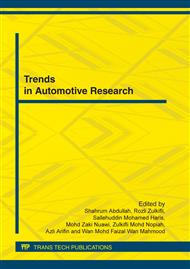p.182
p.187
p.192
p.197
p.202
p.209
p.214
p.219
p.224
Design and Development of UTeM Perodua Eco-Challenge Vehicle
Abstract:
This paper presents the design and development of the UTeM Perodua Eco-Challenge vehicle. The aim of the project was to develop a new generation of fuel efficient car which able to travel the longest distance using 0.5 liter of RON95 fuel. The eco-car was designed as a single seat rear wheel drive vehicle powered by a 660cc fuel injection engine with manual 5-speed transmission and weighs of 355 kg with 30:70 load distribution. The key design features of the fuel efficient car were also discussed in this paper such as space frame chassis design, braking system, composite bodywork and suspension system. Modifications on the engine were also discussed such as engine management to further increase the vehicle fuel efficiency.
Info:
Periodical:
Pages:
202-208
Citation:
Online since:
April 2012
Keywords:
Price:
Сopyright:
© 2012 Trans Tech Publications Ltd. All Rights Reserved
Share:
Citation:


